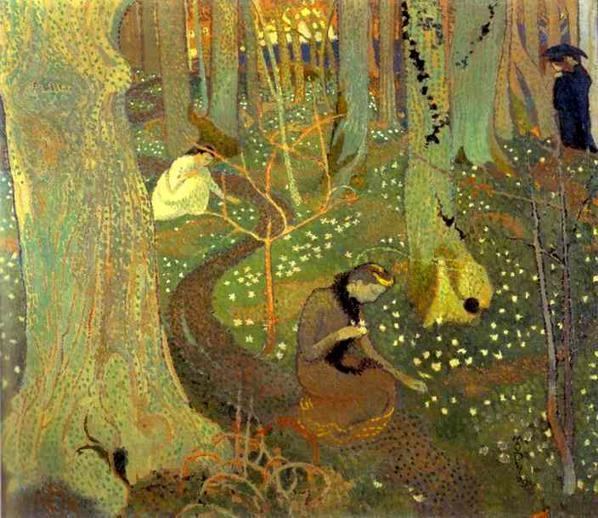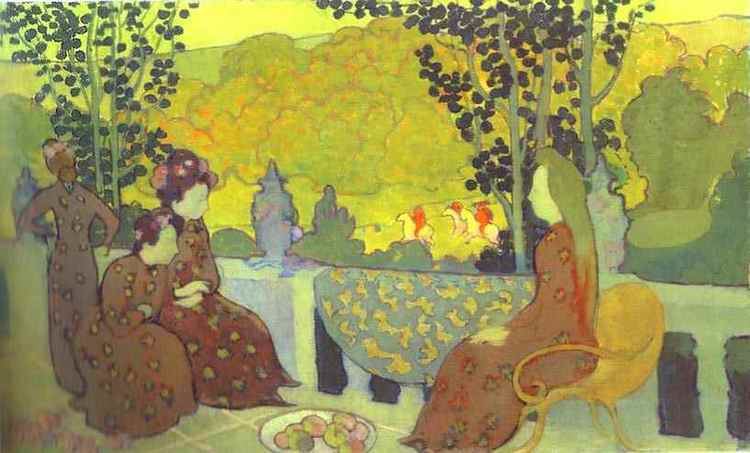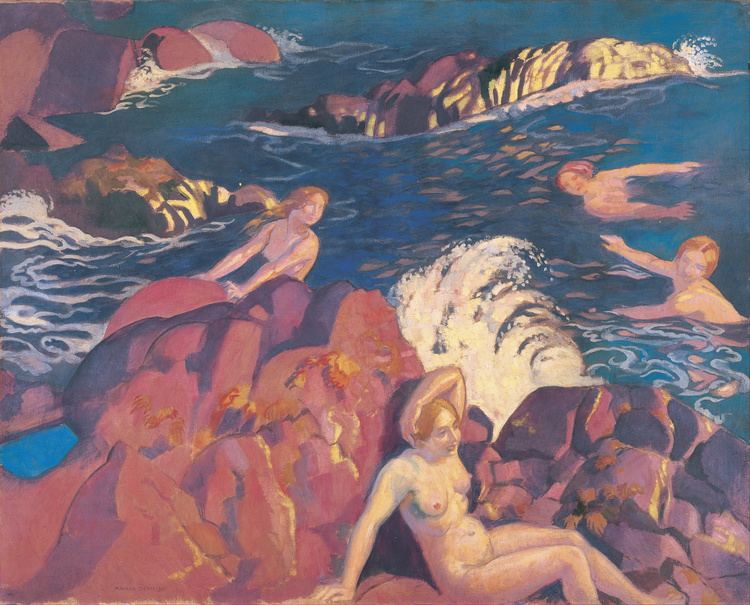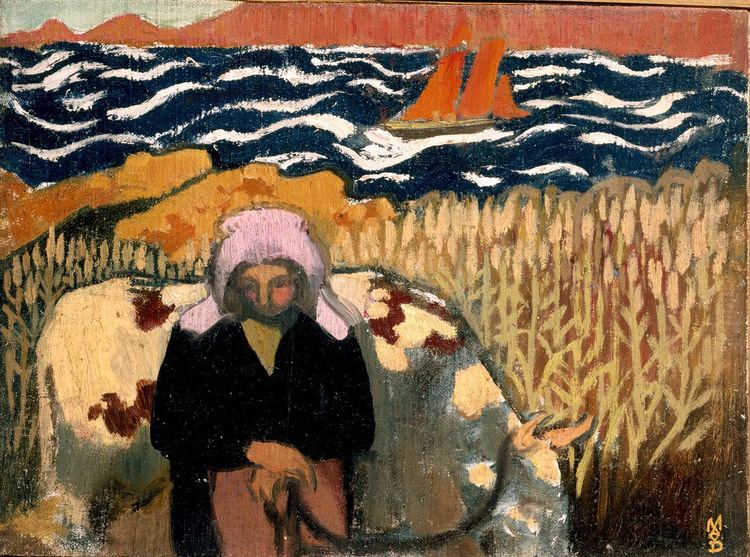Full Name Maurice Denis Role Painter Name Maurice Denis | Nationality French Education Academie Julian | |
 | ||
Died November 13, 1943, Paris, France Artwork Homage to Cezanne, The Muses Spouse Elisabeth Graterolle (m. 1921–1943), Marthe Meurier (m. 1893–1919) Children Noelle Maurice-Denis Boulet Similar People | ||
Maurice denis a collection of 324 paintings hd
Maurice Denis ([dəni]; 25 November 1870 – 13 November 1943) was a French painter and writer, and a member of the Symbolist and Les Nabis movements. His theories contributed to the foundations of cubism, fauvism, and abstract art.
Contents
- Maurice denis a collection of 324 paintings hd
- Maurice denis
- Early life
- A flat surface covered with colors assembled in a certain order
- Late Work
- Theory
- Personal life
- Exhibitions
- References

Maurice denis
Early life

Maurice Denis was born 25 November 1870, in Granville, Manche, a coastal town in the Normandy region of France. His father was of modest peasant origins; after four years in the army, he went to work at the railroad station. His mother, the daughter of a miller, worked as a seamstress. After their marriage in 1865, they moved to Saint-Germain-en-Laye in the Paris suburbs. His father was employed in the offices the administration of the Western Railroads in Paris.

Maurice was an only child. From an early age, his passions were religion and art. He began keeping a journal in 1884 at the age of thirteen. In 1885 he recorded in his journal his admiration for the colors, candle light and incense of the ceremonies at the local church. He frequented the Louvre, and admired especially the works of Fra Angelico, Raphael and Botticelli. At the age of fifteen he wrote in his journal, "Yes, I must that I become a Christian painter, that I celebrate all the miracles of Christianity, I feel that is what is needed." In 1887 he discovered a new source of inspiration, the works of Puvis de Chavannes.

Denis was accepted as a student at one of the most prestigious Paris schools, the Lycée Condorcet, where he excelled at philosophy. However, he decided to leave the school at the end of 1887 and in 1888 enrolled in Académie Julian to prepare for the entrance examination to the École des Beaux-Arts in Paris. There he studied with the painter and theorist Jules Joseph Lefebvre. He passed the entrance examination for the Beaux-Arts in July 1888, and passed another examination in November to receive his baccalaureate in philosophy.
At the Académie Julian, his fellow students included Paul Sérusier and Pierre Bonnard, who had shared ideas about painting. Through Bonnard he met additional artists, including Édouard Vuillard, Paul Ranson, Ker-Xavier Roussel and Hermann-Paul. In 1890 they formed a group which they called the Nabis, taken from "Nabi"—Hebrew for "Prophet". Their philosophy was based upon the philosophy of positivism, and the writings of Auguste Compte and Hippolyte Taine. I rejected naturalism and materialism in favor of something more idealistic. Denis described it in 1909: "Art is no longer a visual sensation that we gather, like a photograph, as it were, of nature. No, it is a creation of our spirit, for which nature is only the occasion."
For his technique, Denis was first drawn toward the neoimpressionist style of Seurat, but rejected it as too scientific. In 1889, Denis was captivated by an exposition of works of Gauguin and his friends at the Cafe Volponi, on the edge of the Paris Universal Exposition of 1889. Recalling it later, Denis wrote, "What amazement, followed by what a revelation! In place of windows opening on nature, like the impressionists, these were surfaces which were solidly decorative, powerfully colorful, bordered with brutal strokes, partitioned." . The work of Gauguin had an immediate effect on Denis' work. The brightly colored forms of Gauguin's Vache au-dessus du gouffre first shown in 1889, appeared in an October 1890 work by Denis, Taches du soleil sur la terrace, and later in Denis' Solitude du Christ (1918).
The Nabis drifted apart by the end of the 1880s, but their ideas influenced the later work of both Bonnard and Vuillard, as well as non-Nabi painters like Henri Matisse.
Another influence on Denis at the time was the art of Japan. The interest of French artists in Japanese arts had begun in the 1850s, then was renewed by displays at the Paris Universal Exposition (1855) and was revived again in 1890 by a major retrospective of Japanese prints at the École des Beaux-Arts. Even before 1890 Denis had been cutting out and studying the illustrations of the catalog Japan Artistique published by Siegfried Bing. In November 1888 he had declared to his friend Émile Bernard that he wanted to move from "Giving color to (Puvis de Chavannes)" to "making a blend with Japan." His paintings in the Japanese style featured a wide format and very stylized composition and decoration, appearing like Japanese screens.
"A flat surface covered with colors assembled in a certain order"
In August 1890, Denis consolidated his new ideas and presented them in a famous essay published in the review Art et Critique. The celebrated opening line of the essay was: "Remember that a picture, before being a battle horse, a female nude or some sort of anecdote, is essentially a flat surface covered with colors assembled in a certain order." This idea was not original to Denis; the idea had been forward not long before by Hippolyte Taine in The Philosophy of Art, where Taine wrote: "A painting is a colored surface, in which the various tones and various degrees of light are placed with a certain choice; that is its intimate being." However, it was the expression of Denis which seized the attention of artists and became part of the foundation of modernism. Denis was among the first artists to insist on the flatness of the picture plane—one of the great starting points for modernism. However, as Denis was at paints to explain, he did not mean that form of the painting was more important than the subject. He went on to write: "The profoundness of our emotions comes from the sufficiency of these lines and these colors to explain themselves...everything is contained in the beauty of the work." In his essay, he termed this new movement "neo-traditionaism", in opposition to the "progressism" of the neo-impressionists, led by Seurat. With the publication of this article, Denis became the chief spokesperson for the philosophy of the Nabis, though in fact that group was very diverse and had many different opinions about art.
The next major event in the life of Denis was his meeting with Marthe Meurier in October 1890. From June 1891 they had a long romance, meticulously documented in his journal, and were married on 12 June 1893. She became an important part of his art, appearing in many pictures and also in decorative works, such painted fans, often as an idealized figure representing purity and love
By the early 1890s, Denis had arrived at the artistic philosophy which guided most of his later work, and which changed very little; that the essence of art was to express love and faith, which to him were similar things. On 24 March 1895 he wrote in his journal: "Art remains a sure refuge, the hope of a reason in life from now on, and the consoling thought that little beauty manifests itself in our lives, and that we are continuing the work of Creation....Therefore the work of art has merit, inscribed in the marvelous beauty of flowers, of light, in the proportion of trees and shape of waves, and the perfection of faces; to inscribe our poor and lamentable life of suffering, of hope and of thought."
The art world was in transition in the early 1890s, with the death of Van Gogh in 1890 and of Seurat in 1891, and the first departure of Gauguin to Tahiti. The French State was gradually giving up its dominance of art through the annual salons it organized. An independent Salon had been formed in 1884 and in 1890 the official Salon broke into two parts, with the formation of the Société national des Beaux-Arts, with its own annual show. Denis showed his works in both salons, as well as the La Libre Esthétique salon in Brussels, a leading European showcase for avan-garde art. The literary movement called symbolism was launched by Jean Moréas in an article in Le Figaro in 1891. In March 1891 the critic George-Albert Dourer wrote an article for the Mercure-de-France calling Denis the leading example of "symbolism in painting". The work of Denis attracted the attention of critics and of important patrons, most notably Arthur Huc, the owner of the prominent newspaper La Dépêche de Toulouse who organized his own art salons and purchased a number of works by Denis.
Denis experimented with other art forms and with decorative art. Beginning in 1889, to illustrate an edition of the book of poems Sagesse by Paul Verlaine, Denis carved a series of seven highly stylized woodblock prints, distilling the essence of his work. His patron Huc commissioned two large decorative panels, in the form of tapestries, for his Toulouse office. Denis, like other artists of the period, also designed colorful lithograph posters with the arabesque curves of the Art Nouveau.
Beginning in 1891, shortly after his engagement, Denis made Marthe the most frequent subject of his paintings; she was depicted, in purified and idealized form, doing household tasks, taking naps, and at the dining room table. She appeared in his landscapes, and in his most ambitious works of the time, The series called the The Muses, which he began in 1893, and showed at the Salon of Independents in 1893. He sold the first painting to his friend Arthur Fontaine; In 1899 The French state acquired one of the paintings, his first official recognition.
His wife played the piano, and throughout the 1890s Denis had a growing interest in the connections between music and art. He painted a portrait of her at the piano in 1890. He designed a flowing lithograph, featuring Marthe, for the cover for the sheet music of La Demoiselle Elue by Claude Debussy, as well as another lithograph for the poem Pelléas et Mélisande by Maurice Maeterlinck, which Debussy transformed into an opera; and in 1894 he painted La Petit Air, based on the poem Princesse Maleine by Stéphane Mallarmé, the most prominent literary proponent of symbolism. In 1893 made a collaborative project with the writer André Gide, which combined art and literature; he provided a series of thirty lithographs to accompany a long essay by Gide, called Voyage d Urien. The Lithographs did not illustrate the text, but approached the same topics from an artist's point of view.
Another topic he addressed in this period was the relationship between sacred love and profane love. The painting had three female figures, two nude and one clothed, following the model of Le Concert Champêtre and L'Amour Sacré et L'Amour Profane of Titian and Déjeuner sur l'herbe by Manet. The setting is his own garden, with the viaduct of Saint-Germain-en-Laye in the background. The nude figures represented sacred love, and he clothed figure profane love. He made another painting, this time of Marthe nude in the garden, representing both sacred and profane love in one figure.
In the mid-1890s, with the appearance of the Art Nouveau style in Brussels and Paris, Denis began to pay greater attention to the decorative arts, though his themes of family and spirituality remained the same. Many of his new projects were commissioned by Samuel Bing, the art dealer whose gallery gave its name to Art Nouveau. His new projects included designs wallpapers, stained glass, tapestries, lamp shades, screens, and fans. But while he worked within the time period and used the materials of the Art Nouveau, his themes and style remained distinctly his own.
His most important decorative work was a series of painted panels for the office of Baron Cochin, together called The Legend of St. Hubert, painted between 1895 and 1897. It drew freely upon the Medici Chapel in Florence, and the works of Nicolas Poussin, Delacroix and Pierre Puvis de Chavannes. Cochin and his family appear in one panel, and Denis's wife Anne in another. The panels celebrated families and faith. The Archibishop of Paris celebrated a mass in the office, when the French government nationalized his residence and other church property in 1907.
He produced a small number of portraits, including an unusual portrait of Yvonne Lerolle (1897) which showed her in three different poses in the same picture.
In January 1898 Denis made his first visit to Rome, where the works of Raphael and Michaelangelo in the Vatican made a strong impression upon him. He wrote a long essay, Les Arts a Rome, declaring: "the classical aesthetic offers us at the same time a method of thinking and a method of wanting to be, a moral and at the same time a psychology...The classical tradition as a whole, by the logic of the effort and the greatness of results, is in some way parallel with the religious tradition of humanity." In the same year, the two leading figures of symbolism in art, Gustave Moreau and Puvis de Chavannes, died. On his return to Paris, Denis re-oriented his art toward neo-classicism, with clearer lines and figures. He noted in his journal in 1908, "Think of late paintings where Christ is the central figure...Remember the large mosaics of Rome. Reconcile the employment of large-scale decorative means and the direct emotions of nature."
Late Work
Subjects of his mature works include landscapes and figure studies, particularly of mother and child. But his primary interest remained the painting of religious subjects, like "The dignity of labour", commissioned in 1931 by the International Federation of Christian Trade Unions to decorate the main staircase of the Centre William Rappard.
Theory
Throughout his career, Denis was an art theorist as well as a painter, always looking for a purpose to his art. In 1890, he wrote: "Art is the sanctification of the nature, of that nature found in everyone who is content to live."
In 1898, he produced a theory of creation that found the source for art in the character of the painter: "That which creates a work of art is the power and the will of the artist."
The Ateliers d'Art Sacré were founded on 5 November 1919 after World War I (1914-18) by Denis and Georges Desvallières as part of a broad movement in Europe to reconcile the church with modern civilization. The Ateliers created art for churches, particularly those devastated by the recent war. Denis said that he was against academic art because it sacrificed emotion to convention and artifice, and was against realism because it was prose and he wanted music. Above all he wanted beauty, which was an attribute of divinity.
Personal life
Denis, a Catholic Tertiary, married his first wife, Marthe Meurier, in 1893. They had seven children, and she would pose for numerous Denis works. Following her death in 1919, Denis painted a chapel dedicated to her memory. Two years later, he married again, to Elisabeth Graterolle, and fathered two more children. Politically, he was close to the monarchist Action Française movement.
Denis died in Paris of injuries resulting from an automobile accident in November 1943. (The date of his death is variously listed as the 2nd, 3rd, or 13th.)
Exhibitions
In 1980, the Maurice Denis Museum was opened in the artist's home in the Parisian suburb of Saint-Germain-en-Laye.
A major retrospective was mounted at the Musée Des Beaux Arts de Montréal in 2007; it was the first major Denis show in North America.
A similar exhibition took place in 1995 at the UK's Walker Art Gallery in Liverpool.
